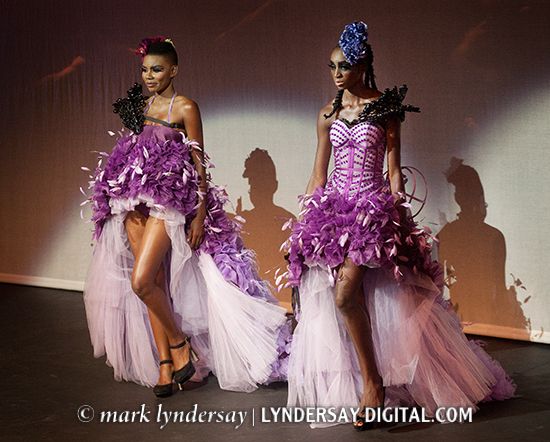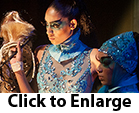Band on the slink
20/08/12 22:09 Filed in: Reviews
K2K Band Launch 2013
A review and photographs by Mark Lyndersay.
Originally published in the Sunday Guardian for August 19, 2012.

K2K Carnival’s costume Skeptic presented at the band’s launch of its 2013 presentation, The Human Race at Queen’s Hall. Photograph by Mark Lyndersay.
Ten days ago, K2K Alliance and Partners, the band designed by Kathy and Karen Norman, introduced their sophomore effort, The Human Race at Queen’s Hall.
The event, in principle a band launch, bore few of the hallmarks of the celebrations we’ve come to understand as an introduction of costumes from a Carnival band.
Billed as “An Elegant Evening of Fashion and Cocktails” with a dress code and something of a severe manner, it was, in structure, more obviously a fashion show, presented as an aspiration to higher culture and intent.
If that seems a bit snobbish, well it’s about time someone honestly put some thing a bit pompous and presumptuous back into Carnival or at the very least, something that betrays a unique perspective and point of view on the idea of having a large group of people pretend to be something else.
The Norman sisters seem quite keen to continue doing so after their debut band this year and remain undeterred in their commitment to offer costuming that’s dramatically cut, precisely rendered and unforgiving in its lack of interest in proliferations of beading and feathers.
That’s not to say the work is spare. The Human Race spared no glitter in its enthusiasm to shine and little froufrou in putting flounce into skirts.
If the music introducing the costumes at the event was very much the type of racy techno and industrial dance music that’s become commonplace as accompaniment costume appearances at a band launch, the stark lighting, languid walks onstage and smoky glances from the models wearing the costumes were very much the stuff of high fashion.
 The Norman sisters are using the term couture to describe their work in Carnival. It’s a term normally used for small runs to hand fitted clothing from an exclusive clothier and their efforts to make the term work in the context of Carnival are, by turns, admirable, astonishing and puzzling.
The Norman sisters are using the term couture to describe their work in Carnival. It’s a term normally used for small runs to hand fitted clothing from an exclusive clothier and their efforts to make the term work in the context of Carnival are, by turns, admirable, astonishing and puzzling.
In the architecture of the band, each section offers three interpretations of the costume style and masqueraders will be choosing to be either a Thoroughbred, Jockey or Onlooker (also described as Crowd and Spectator) in each section of the band.
The nuances in the costuming within each section prove to be quite clever. Thoroughbred costume versions tended to emphasise more skin in their design emphasising the long, sleek legs of the night’s models. Jockey versions of the costumes gently covered the model's legs with skirts and wraps.
Some skirts drag insouciantly along the ground while the micro-mini skirts of the Visionary section are probably the most appealing thing I’ve seen a woman plan to wear for Carnival in decades.
 While there are some lovely costumes that might appeal to a masquerader of roughly the same age as the young models parading K2K’s costume that night, it’s also clear that overall, this isn’t a jam, wine and back-back band.
While there are some lovely costumes that might appeal to a masquerader of roughly the same age as the young models parading K2K’s costume that night, it’s also clear that overall, this isn’t a jam, wine and back-back band.
The costumes are designed for wearing, parading and even a little dignified dancing but jam two of them together and you’ll probably redefine the term wardrobe malfunction.
The band successfully hit the road for the first time in 2012 and made quite an impression crossing the Queen’s Park Savannah stage, but the buzz about the masquerader experience suggests that for 2013 there will have to be more emphasis on customer comfort and convenience, not simply as a sales tool but more as an absolute necessity.
At least half of these costumes make use of long flowing skirt forms, some full and ruffled, others adventurously alternate full pleating with transparent netting. Men’s costumes seem perfunctory compared to the ornate detail and dramatic design of the female choices and the band seems set to continue as a statement by a certain kind of mature woman about style, fashion, costuming and a presence on the road at Carnival.
There are bold design cutaways in The Human Race, some of them entertainingly whimsical, notably in some the men's Jockey costumes, which are missing entire backs and halves. Half of the Imagination costume is daringly absent, sliced away along the length of the model in the design.
Padding elements normally used to shape hips and shoulders become shaped and decorated armor plates, inverting function into aggressive style.
The dramatic presentation of the costumes came to an oddly confused end with the introduction of the popular rapso group 3 Canal, whose uptempo message of good vibrations overturned the brooding mood and left the models on stage with a radical change in tone they didn’t seem prepared for.
Kathy and Karen Norman then appeared with director Mervyn de Goeas to much applause and even more staging confusion before 3 Canal reappeared for another upbeat closing song for no thematic reason that I could divine.
It will, overall, be remembered be as a pointedly brief, briskly choreographed show that successfully introduced the band as a collection of bold designs while leaving the concept underpinning them still quite opaque.
A stapled together collection of letter-sized printouts given to the press answered little. The show was apparently arranged, according to this guide, into three “clusters” with an accompanying narrative full of headache inducing horse race metaphors that made little sense.
Better to set aside all that and appreciate the costumes as both works of bold fashion and adventurous costuming then, and on those terms, the story of the Norman’s Human Race seems promising indeed.
A review and photographs by Mark Lyndersay.
Originally published in the Sunday Guardian for August 19, 2012.

K2K Carnival’s costume Skeptic presented at the band’s launch of its 2013 presentation, The Human Race at Queen’s Hall. Photograph by Mark Lyndersay.
Ten days ago, K2K Alliance and Partners, the band designed by Kathy and Karen Norman, introduced their sophomore effort, The Human Race at Queen’s Hall.
The event, in principle a band launch, bore few of the hallmarks of the celebrations we’ve come to understand as an introduction of costumes from a Carnival band.
Billed as “An Elegant Evening of Fashion and Cocktails” with a dress code and something of a severe manner, it was, in structure, more obviously a fashion show, presented as an aspiration to higher culture and intent.
If that seems a bit snobbish, well it’s about time someone honestly put some thing a bit pompous and presumptuous back into Carnival or at the very least, something that betrays a unique perspective and point of view on the idea of having a large group of people pretend to be something else.
The Norman sisters seem quite keen to continue doing so after their debut band this year and remain undeterred in their commitment to offer costuming that’s dramatically cut, precisely rendered and unforgiving in its lack of interest in proliferations of beading and feathers.
That’s not to say the work is spare. The Human Race spared no glitter in its enthusiasm to shine and little froufrou in putting flounce into skirts.
If the music introducing the costumes at the event was very much the type of racy techno and industrial dance music that’s become commonplace as accompaniment costume appearances at a band launch, the stark lighting, languid walks onstage and smoky glances from the models wearing the costumes were very much the stuff of high fashion.

In the architecture of the band, each section offers three interpretations of the costume style and masqueraders will be choosing to be either a Thoroughbred, Jockey or Onlooker (also described as Crowd and Spectator) in each section of the band.
The nuances in the costuming within each section prove to be quite clever. Thoroughbred costume versions tended to emphasise more skin in their design emphasising the long, sleek legs of the night’s models. Jockey versions of the costumes gently covered the model's legs with skirts and wraps.
Some skirts drag insouciantly along the ground while the micro-mini skirts of the Visionary section are probably the most appealing thing I’ve seen a woman plan to wear for Carnival in decades.

The costumes are designed for wearing, parading and even a little dignified dancing but jam two of them together and you’ll probably redefine the term wardrobe malfunction.
The band successfully hit the road for the first time in 2012 and made quite an impression crossing the Queen’s Park Savannah stage, but the buzz about the masquerader experience suggests that for 2013 there will have to be more emphasis on customer comfort and convenience, not simply as a sales tool but more as an absolute necessity.
At least half of these costumes make use of long flowing skirt forms, some full and ruffled, others adventurously alternate full pleating with transparent netting. Men’s costumes seem perfunctory compared to the ornate detail and dramatic design of the female choices and the band seems set to continue as a statement by a certain kind of mature woman about style, fashion, costuming and a presence on the road at Carnival.
There are bold design cutaways in The Human Race, some of them entertainingly whimsical, notably in some the men's Jockey costumes, which are missing entire backs and halves. Half of the Imagination costume is daringly absent, sliced away along the length of the model in the design.
Padding elements normally used to shape hips and shoulders become shaped and decorated armor plates, inverting function into aggressive style.
The dramatic presentation of the costumes came to an oddly confused end with the introduction of the popular rapso group 3 Canal, whose uptempo message of good vibrations overturned the brooding mood and left the models on stage with a radical change in tone they didn’t seem prepared for.
Kathy and Karen Norman then appeared with director Mervyn de Goeas to much applause and even more staging confusion before 3 Canal reappeared for another upbeat closing song for no thematic reason that I could divine.
It will, overall, be remembered be as a pointedly brief, briskly choreographed show that successfully introduced the band as a collection of bold designs while leaving the concept underpinning them still quite opaque.
A stapled together collection of letter-sized printouts given to the press answered little. The show was apparently arranged, according to this guide, into three “clusters” with an accompanying narrative full of headache inducing horse race metaphors that made little sense.
Better to set aside all that and appreciate the costumes as both works of bold fashion and adventurous costuming then, and on those terms, the story of the Norman’s Human Race seems promising indeed.
blog comments powered by Disqus